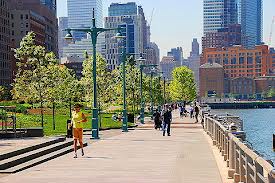Will longest waterfront park in the U.S. survive?
 The Hudson River Park (HRP) in the West Side of Manhattan runs five miles long — from Tribeca, Greenwich Village and Chelsea all the way north to Hell’s Kitchen and Clinton. It is the longest waterfront park in the United States. But it is not a city or state park; therefore, it does not receive any government money for its maintenance and operations.
The Hudson River Park (HRP) in the West Side of Manhattan runs five miles long — from Tribeca, Greenwich Village and Chelsea all the way north to Hell’s Kitchen and Clinton. It is the longest waterfront park in the United States. But it is not a city or state park; therefore, it does not receive any government money for its maintenance and operations.
HRP is supposed to finance itself, which it has done since its creation — by way of commercial leases and private fundraising. Unfortunately, its operating costs have ballooned in recent years due to deteriorated pier pilings, collapsed bulkheads and damage caused by Superstorm Sandy. For Fiscal Year 2013, HRP is projecting a $7 million deficit to pay for these critical capex and maintenance repairs, which would rise to a whopping $9 million annual deficit by 2022.
But the Park won’t make it that long, because unless something is done immediately to cover these projected deficits, HRP will run out of money by FY 2017. Due to this precarious financial situation, many concerned neighbors, residents, donors, community leaders, real estate developers and elected officials have come together to find ways to help the Park regain its path towards self-sustainability.
One idea that is being pursued by the non-profit organization Friends of Hudson River Park (FOHRP), is the creation of a “Neighborhood Improvement District” (or NID — http://www.hrpnid.org/), which would use the same legal structure and funding mechanism allowed under the City’s Business Improvement District legislation. FOHRP invited me to join the Steering Committee for the creation of this NID nearly two years ago.
Under our proposal, commercial and residential owners closest to the Park would pay a small annual property assessment. With nearly 100 million square feet of built real estate next to the Park, this tiny charge would actually raise about $10 million per year. The money would be collected by the City’s Department of Finance along with the City’s annual property taxes. However, the NID money would not be comingled with the City’s general funds; instead, it would be transferred directly (and fully) to the NID.
After two years of surveys, consultations, analysis and debate — we are at that stage in the project where we must formally disclose to anybody interested (as required by law) all the details of the draft District Plan. FOHRP and members of the Steering Committee have held six public meetings (double that required by law) to share the particulars. But as you can well imagine whenever there is talk of change, or worse yet any type of levy that resembles a tax, there is bound to be opposition.
Here is a well-written article that recently appeared in The Villager that lays out quite succintly the arguments against the NID (http://www.thevillager.com/2013/02/21/is-nid-really-needed-and-who-asked-for-it-anyway/). FOHRP asked me to respond to it:
================
To The Villager Editor:
I am responding to Eileen Stukane’s article in the February 21st edition of The Villager, entitled “Is NID really needed, and who asked for it anyway?”
My name is Raul Larios and I serve on the Steering Committee (SC) of the Hudson River Park NID to which Ms. Stukane is referring. I have no problem with the 1st half of her article; it is factually correct, and I thank her for at least getting her facts straight. However, I do have a problem with some of her conclusions. For example, her claim that the “public meetings do not seem to offer a plan in progress but rather, a plan in place” is simply unfair. The current draft of the District Plan looks quite different from the original one nearly two years ago when I joined the SC. During that time, the SC has paid careful and deliberate attention to all comments and feedback that have been received prior to, during and after the public meetings. We have analyzed them, debated them and incorporated many of the suggestions into each successive draft of the Plan.
Case in point are the current proposed boundaries of the NID, which have not yet been finalized mainly because we are still hearing from the community regarding certain pros and cons of different layouts. In short, the District Plan is NOT in place, and even at this late hour is still a work in progress. We do hope to finish it in the next couple of weeks since our goal is to submit a finalized version to the City by the end of March. Until then, we welcome any and all comments.
If you wish, you can email your remarks to me at raul.larios1@gmail.com instead of Friends of Hudson River Park (FOHRP), if that’s your concern. I will make sure they get heard at the next SC meeting; although I can assure you that FOHRP would never hold back any comments or suggestions for the formation of this NID, even if negative. In fact, quite the opposite is true — it’s the good people at FOHRP who constantly bring to our attention any negative feedback for debate and resolution.
Regarding Ms. Stukane’s observation that “the NID Steering Committee…is comprised of 23 members. Of those, 10 are major real estate developers…”, she seems to imply that somehow they are running or controlling the meetings. Having attended every single meeting since I joined the SC nearly two years ago, I can assure you that nothing could be farther from the truth. The real estate developers have always been cordial and professional — but somewhat reserved in their participation. Most of the debating has transpired amongst the 13 community members, including (by the way) the composition of the Committee. Technically speaking, the community now has a majority (13 to 10), but we’ve never had to use it because all decisions taken (including revisions to the District Plan) have been unanimous.
Regarding Ms. Stukane’s complaint that “three — only three — residential owners” sit on the Committee, let me assure you that it’s not from lack of trying. The SC reached out to dozens of owners, but for one reason or another, only three decided to join. Had I known that Ms. Stukane loved the Park so much, I would have reached out to her personally.
Regarding Ms. Stukane’s allegation that “rather than planning a neighborhood improvement district mostly with prominent real estate developers, and then informing residents after the fact, the NID could have truly been a grassroots movement”, I want to let you know that I personally dragged representatives from FOHRP to nearly a dozen well-attended neighborhood and Community Board events, as well as to one-on-one meetings with individual residents in Chelsea, Clinton and Hell’s Kitchen. The same has been the case with my colleagues on the SC who live in the Village and Tribeca.
So the answer to the questions posed by Ms. Stukane is that the NID is in fact really needed financially, and it’s the community who is asking for it.
Thank you for the opportunity to set the record straight.
-
Recent
- PART 2 – Should Nonprofits Strive to be Profitable?
- Should nonprofits strive to be profitable? PART 1.
- Will Changes in N.Y. Non-profit Laws Cause Board Resignations?
- Is Fraud at Non-profits Significant?
- Are U.S. Nonprofits with Operations in Latin America Subject to FCPA?
- Part 3 – The Drug Kingpin Act…
- Part 2 – The Reality…
- Want to Invest in Honduras? Tread Carefully!
- New Yorkers…how safe is your cooking gas?
- Did Walmart CEO Know of Mexican Bribes?
- Will longest waterfront park in the U.S. survive?
- Will Fracking Be Approved in New York?
-
Links
-
Archives
- April 2015 (2)
- April 2014 (1)
- January 2014 (1)
- November 2013 (1)
- September 2013 (1)
- July 2013 (1)
- June 2013 (1)
- May 2013 (1)
- April 2013 (1)
- March 2013 (1)
- February 2013 (1)
- January 2013 (1)
-
Categories
-
RSS
Entries RSS
Comments RSS
